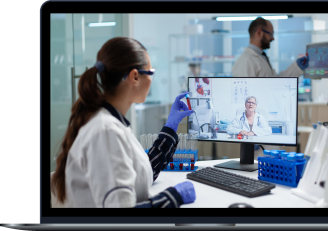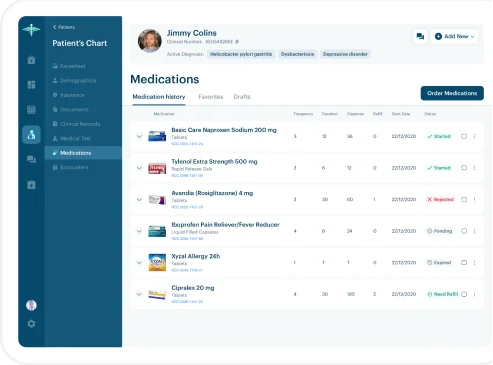Telemedicine app development: from idea to post-release support
-
Extend your service offerings and deliver remote care with a quality telehealth solution
-
Serve more patients and reduce your staff’s workload with virtual consultations
-
Provide 24/7 access to healthcare for patients in remote locations
-
Modify treatment for patients with chronic conditions using remote patient monitoring
Why choose Yalantis for telemedicine app development?
-
98%
customer satisfaction rating
-
30+
telehealth products delivered
-
10+
years of healthcare development experience
-
100%
compliance with healthcare laws and regulations
Our telemedicine app development solutions
Yalantis helps healthcare practices deliver patient-centered services with customized telehealth and telemedicine solutions
-
Virtual hospital software
-
Secure live video streaming and waiting room
-
Virtual front-desk triage and scheduling
-
Live chat support
-
-
Online appointment scheduling
-
Telehealth visit scheduling via mobile or web applications
-
Efficient appointment tracking and management
-
Visibility of doctor availability
-
Automated payment system
-
-
Remote patient monitoring
-
Health logs for keeping track of patients’ progress
-
Integration with medical devices to measure vitals
-
Notification and alert system for clinicians and patients
-
-
Communities, portals, and secure messaging
-
Unified patient portal
-
24/7 access to medical information for patients
-
Healthcare support via messages
-
Health education for patients
-
Build FDA-Compliant Healthcare Software
Get our ISO 13485 & FDA compliance guide covering medical software certification, regulatory pathways, and step-by-step implementation framework.
Value that our telemedicine app development company has delivered to clients
Add value to your medical practice with telemedicine software
We deliver solutions that bring tangible results, improve the quality of services, decrease medical staff overload, and help you monitor more patients even in the most remote locations
Insights into telehealth app development

A roadmap to developing an all-in-one telehealth solution
Learn how to implement an all-around telehealth solution fast and easily to serve patients and providers during the coronavirus pandemic and after it passes.

Benefits of remote patient monitoring and use cases for healthcare providers
Learn the present-day benefits of remote patient monitoring and use cases that can help your business elevate patient satisfaction, expand healthcare offerings, and modernize patient care approaches within your healthcare organization

Aspects to consider when developing a mental health app
This post talks about the categories of mental health apps, features, and important aspects to take into account for mental software solutions.
FAQ
How do you ensure smooth and cost-efficient telehealth app development?
To ensure a highly efficient telehealth app development process, we provide you with experts who are well-versed in specific healthcare domains. These team members can quickly choose relevant technologies and can provide you with solid advice. Software interoperability is considered one of the most common issues in healthcare software development, and domain experts are better equipped than regular software developers to ensure proper implementation of your new telehealth solution into your existing digital healthcare network.
If you’re building a new telemedicine app, we recommend developing an MVP first so you can test a working solution with your users and stakeholders without investing lots of time and money. Upon receiving customer feedback, we can work together to build a full-fledged system. Without an initial MVP version, such a system will be harder to promote, and you won’t have the privilege of considering user feedback.
Security is also critical when developing a telemedicine platform. By implementing a security-by-design strategy at the initial stages of development, our team can guarantee fewer costly security risks when the application is released to production. Cooperating with an experienced team is your go-to strategy if you’re looking for fast yet high-quality development services.
Do you customize your telemedicine software development services according to the needs of different healthcare practices?
We can build a telemedicine solution tailored to the needs and specializations of your healthcare organization. For instance, you could build a telehealth application only for certain types of services, such as monitoring and managing chronic diseases, or for primary care only, including functionality for onboarding new patients and scheduling first-time visits. Combining several types of services in a single application is also an option. For example, you could provide mental health support along with remote physical therapy.
However, a custom telehealth solution doesn’t have to be rigid. We build flexible and scalable solutions, allowing you to enhance your telehealth app with additional functional modules as your healthcare organization grows and changes. With tailored telehealth app software, you can also cover certain gaps in your healthcare practice, such as providing your patients with nutrition support.
What are the benefits of cooperating with a telemedicine app development company rather than adopting an existing telehealth solution?
If you adopt a ready-made telehealth solution, you’ll face a range of challenges such as paying extra for essential features or working around functionality that you don’t need. With existing solutions, you’ll need to accept a number of tradeoffs in exchange for fast implementation. In turn, outsourcing telemedicine software development may require more investments at the beginning but can add value to your business in the long run.
With a unique telehealth platform, you can stand out from competitors and attract more patients even from locations that weren’t accessible to you before. If you provide non-typical healthcare services and your business is new to the market, a custom telemedicine app can also be the right option for you to digitalize your services and strengthen your position in the market, offering a convenient and accessible way for potential patients to get to know your business.
You can still consider adopting a ready-made solution, but we recommend doing so only for research and testing purposes. This way you’ll find out which features you can use in your custom telehealth solution and which obvious drawbacks to avoid. You can then share your findings with our team and we’ll develop telemedicine software that will perfectly fit your medical practice.
What are the software development stages at your telehealth app development company?
We always begin with several rounds of negotiations, during which we learn as much as you’re willing to share about your business. Then, we elicit your critical project and compliance requirements and decide on the type of product to develop: a minimum viable product or a full-fledged system. We also make a preliminary project estimate and define the scope of work. At this stage, you will communicate mostly with our business analysts and experts in healthcare technologies.
Next, we proceed to the discovery stage, which includes preparing a feature roadmap for your telehealth solution, composing a team, and conducting design and market research. Once everything is set up, we move on to the actual development stage, during which design, development, and testing specialists work in parallel to iteratively deliver the expected results and hit critical milestones. Finally, we reach the launch of your telehealth product and can measure the results of our cooperation. But this isn’t the end, as we also provide extensive post-release support and assist you with system maintenance whenever you need it.
And if you need to scale your system or change its functionality, you can always request our services again and won’t need to spend time looking for another software development partner.
How to prepare for the telehealth software development process
To prepare for telehealth development, you need to produce detailed business requirements and have a clear vision of the solution you need. The more detailed the requirements and expectations you share with your development team, the more time you can save during the discovery stage and the faster you can start with development. However, if you’re new to healthcare development, we can assist you with gathering the right specifications and conducting market research, and we can even help you build a vision for your future telemedicine app.
Another important aspect of preparing for an efficient development process is providing your development partner with the results of preliminary target audience analysis. This data will lay the foundation for more in-depth research and help us choose the right direction in terms of UI/UX design, third-party integrations, and, of course, critical functionality.
How to encourage clinicians and patients to use telehealth software
Once your telehealth solution is released, you may face difficulties with encouraging medical staff and patients to use it. Possible solutions could include the following:
- Providing training programs for clinicians and patients with clear onboarding instructions
- Creating a landing page on your company website and presenting the new telehealth solution
- Launching an email campaign about the new software among your existing patients
- Regularly communicating the benefits of using this software with your staff and patients
- Ensuring an on-demand technical support team that helps users quickly tackle any issues and reduces anxiety while using the new software
- Introducing benefits and loyalty programs for frequently using telehealth software
- Taking into account user feedback and fixing any software issues in a timely manner
If you follow these simple tips, it will be easier for you to encourage the quick adoption of new technology among your employees and clients. But if adoption difficulties persist, we can develop an individual product promotion strategy for you.
How many features should a telemedicine app include?
The functionality set of your telehealth software largely depends on your audience’s needs. If you overwhelm the system with too many features, users may get frustrated and may even delete the app shortly after downloading it. Plus, app functionality directly depends on your medical practice’s specialization, user roles, and the services you provide. Some basic features to include in your telehealth app are the following:
For patients:
- Videoconferencing
- Scheduling consultations
- Reminders of upcoming appointments
- Tracking health conditions
- Integrating with fitness devices
- Health statistics
For physicians:
- Videoconferencing
- Calendar to manage appointments
- Dashboard with patient information
- Integration with EHR systems
- Functionality for creating treatment plans
Keep in mind that you may not need all of these features. Together, we can develop a detailed feature map for your unique telehealth system.
What impacts telehealth app development cost?
The cost of developing a telemedicine solution depends on many factors. One of the most significant is whether you will develop a telemedicine app starting with an MVP version or build a full-fledged version right away. A full-scale solution includes a larger functionality set and requires a bigger development team as well as more development time.
Another aspect that influences development cost is the number of platforms you want your solution to be available on. If you need both a web app and an Android and iOS app, the price will be higher than for a single web or mobile app.
When estimating your project, we also take into account the number of third-party integrations. Any regional security laws and regulations that require additional research on our side can also increase the price of our services. Uncommon design requests that require many skilled specialists for a single project impact the price as well.
These are a few factors that affect the cost of development, but we approach each project as a unique story, so there might be some additional considerations. It’s important to note that we always aim to minimize your costs and openly communicate with you throughout the whole project estimation process.
Telehealth software development: Deep dive into telehealth functionality and technology
You should adopt or develop a telehealth app in line with your healthcare facility’s needs. Don’t rush into development merely to keep up with the growing trend (propelled by the COVID-19 pandemic) of adopting telehealth solutions. On the other hand, if you do have a clear vision of how a telehealth software system can benefit your business, you should understand what the telemedicine software development process consists of. For that reason, we’ve prepared a comprehensive guide to telehealth benefits, critical components of a telehealth app, architectural specifics, suitable technologies, implementation tips, and a quick glimpse into the future of telehealth technology.
How can medical practices benefit from creating a telemedicine app?
Telemedicine system development can help your medical practice in many ways. Let’s take a look at some of the most common yet valuable benefits:
The possibility to attract and retain more patients and reduce the rates of no-shows and hospital readmissions
A telehealth solution can help medical practices increase their patient reach and attract more patients from rural locations. In this way, medical practices can increase revenue and expand their service offerings. Plus, a telehealth product can increase loyalty of existing patients by allowing them to request healthcare services more frequently and quickly consult with their clinicians about treatment plans or medication dosages.
Thanks to telemedicine development, medical practices can decrease patient no-shows, as visiting doctors virtually is much easier than coming to a facility in person. Plus, patients can receive in-app notifications about upcoming visits, increasing the likelihood that they’ll show up on time. With telehealth solutions, physicians can also improve remote patient monitoring and reduce hospital readmissions, which often happen because of inconsistent or incorrect home care.
Improved patient experience and increased workflow efficiency
Telemedicine software can also help you increase patient satisfaction. With a functional mobile telehealth app, patients can easily book and manage appointments, get reminders on upcoming visits, and track their treatment progress. For patients with serious chronic diseases, in-person visits can be especially difficult, and with a convenient mobile telemedicine app, patients can receive necessary care without leaving their homes.
Developing a telemedicine app can also improve overall efficiency at a healthcare facility by decreasing patient wait times, reducing treatment costs, and providing healthcare practitioners with more flexible schedules. In addition, physicians can perform group consultations with several patients at once (ensuring that patients don’t see and hear each other), saving much time and delivering more value.
Common components of a telehealth software solution
In most cases, a telehealth solution is a multi-component ecosystem that consists of both patient-facing and clinician-facing mobile and/or web applications. Here are a few typical components of such a solution:
- Videoconferencing. A telemedicine app should allow patients and clinicians to securely communicate with each other via video or audio.
- Appointment scheduling. When using a telehealth app, patients should have the possibility to book a consultation, and clinicians, in turn, should have a calendar with upcoming appointments.
- Secure messaging. Telemedicine applications should also have chat functionality, allowing clinicians to monitor patients’ conditions after the consultation and allowing patients to ask questions about their treatment.
- Integration with electronic health record (EHR) systems. If telemedicine software is integrated with the EHR system, healthcare practitioners can ensure the safe centralized storage of all patients’ electronic health records and easily access any patient’s data in real time during a telehealth visit.
- Payment management. Telemedicine systems can also include secure and reliable payment processing functionality, allowing patients to easily pay for online doctor visits.
- Integration with medical IoT devices. Thanks to such integration, clinicians can view patients’ vitals in real time during sessions or gather patients’ vitals over time to provide personalized treatment plans.
- Data analytics. To assist in clinical decision-making, telemedicine applications can include data analytics functionality so that clinicians can assess treatment progress over time and monitor the frequency and effectiveness of telehealth visits.
A holistic telehealth solution requires a substantial approach to developing a secure software architecture design and choosing the right technologies. We’ll share with you typical architectural approaches and technology options to choose from when beginning the development of a telehealth mobile app or web app. And based on our experience, we’ll also provide you with a few practical tips on successfully implementing telehealth software in your healthcare practice.
How we build a telehealth application architecture
Telecommunications technologies lie at the heart of any telemedicine app development solution that requires real-time videoconferencing between patients and clinicians. We often give preference to ready-made video and audio solutions such as Wowza, Flashphoner, and TokBox, as they save development time and often come with an established basic architecture. These services are also customizable to fit different projects’ needs.
Core aspects of telemedicine app architecture development
A telemedicine app’s architecture must also account for integrations with other software systems that are present at a certain healthcare facility, such as an electronic health record (EHR) system, hospital information system (HIS), practice management system, and medical imaging system. Proper software interoperability allows your telehealth solution to exchange data with other software solutions and keep everyone in the medical facility regularly updated on the daily workflow. Interoperability is also critical if you need to regularly perform analytics on patient and clinical data and track your business KPIs, such as average time per patient visit.
When working on the architecture of telemedicine app development solutions, we also pay attention to industry-standard security measures, role-based access management, and data storage. These architectural components can differ depending on your requirements, but what’s constant is that we always choose only third-party development services (e.g. cloud vendors) that comply with relevant healthcare laws such as HIPAA as well as any other applicable compliance requirements.
If you want your telehealth system to integrate with medical IoT devices, we also make sure this integration is thought out and reflected in the architectural design (IoT solutions for healthcare). To make the most of this integration, you can include a remote patient monitoring module in your telehealth solution to collect patients’ clinical and fitness data for data-driven diagnostics and treatment management.
Best-fit technologies to develop a telemedicine app
To develop secure and high-performance telehealth products, we’ve accumulated a significant knowledge base and a list of the most suitable technologies. But we also try to keep up with industry trends as well as to enrich this knowledge base and provide up-to-date solutions to a wide range of healthcare businesses globally.
For instance, to enable streamlined videoconferencing functionality and real-time connections, we implement a peer-to-peer network with the WebRTC protocol. For encrypting sensitive user data and passwords, we use the most recent security tools such as the SHA hashing algorithm. We also follow FHIR and HL7 interoperability standards for securely storing, sharing, and retrieving medical data. Our go-to cloud services provider is Amazon Web Services (AWS), as Amazon creates an extremely secure environment for hosting healthcare applications and ensures compliance with healthcare laws.
Before developing a telemedicine app, we always validate with our clients the final architectural design of their future telehealth solution as well as the technology stack to keep them actively involved in the decision-making process. Discussing technology choices with business clients isn’t a common practice for the majority of outsourcing software development companies, but at Yalantis, we consider such discussions part of a transparent and trustworthy development process.
Tips for smooth telehealth platform implementation
Once you go through the complete telehealth app development lifecycle with Yalantis, you may face certain challenges with implementing the new solution into your well-established healthcare practice. We’ve prepared a few tips that hopefully will help you streamline the use of your telemedicine platform across all of your healthcare facilities.
- Gather feedback from your clinical staff and conduct patient surveys. This will allow you to identify the issues your employees most frequently face so we can include features in your telehealth software that tackle real people’s daily pain points.
- Discuss your telemedicine app idea with key stakeholders. Make sure to involve all stakeholders within your healthcare organization in defining the goal behind implementing your telemedicine solution as well as the key features it should include.
- Select critical business KPIs to measure application performance. You should decide how you’ll measure the success of your new telehealth system so that together with other decision-makers at your company you can determine which KPIs are most important when it comes to telemedicine services.
- Identify possible risks. Before investing in telehealth application development, define possible risks that can keep you from achieving your goal within the desired time and budget constraints. Such risks can be of a legal, financial, social, or technological character.
- Set up training for medical staff and clear user onboarding for patients. Implementing new software may lead to frustration and increase anxiety among your employees. Interactive training sessions can help your staff quickly get used to the new workflow, and step-by-step user onboarding can facilitate the use of telehealth solutions among patients.
Telehealth app development involves many components, from defining a compelling implementation strategy to building a reliable telehealth solution with a well-designed architecture and a suitable technology stack that ensures a sufficient level of system security and sufficient protection of sensitive health data. The architecture of a telehealth application is of utmost importance. A proper architecture ensures timely system availability and responsiveness and other critical non-functional requirements for the telehealth platform.
The future of telehealth software and how to remain competitive
Adoption of telehealth solutions is only growing, and many healthcare companies worldwide have started seeing the benefits of telehealth in the post-pandemic reality. Patients can receive quality care from the comfort of their home, and healthcare practices can reduce in-person visits and unburden clinical staff. These are some trends in the telehealth industry:
- Integration of artificial intelligence (AI) and machine learning (ML) algorithms in a telemedicine app can assist clinicians in fast decision-making and in generating personalized educational content for patients who want to improve their lifestyles (machine learning use cases).
- Audience-centered UI/UX design is also a quickly proliferating trend, which means that telemedicine applications should be designed around the needs of a specific audience. For example, if your primary target audience is elderly people, you should focus on simple navigation, bright colors, and large buttons.
- A focus on mental health telehealth services is becoming widespread, as patients often find it intimidating to deal with their sensitive health issues at physical healthcare facilities, and it’s much more comfortable to get mental health support via a video call.
- The expansion of telehealth-specific hardware can significantly improve telehealth service delivery. For instance, AMD produces VersaScope multipurpose medical cameras that enable remote general purpose, dermatology, and otoscopy examinations. It’s a simple solution for creating digital images and performing accurate remote consultations.
To build a telemedicine app that remains competitive for years, you should keep up with the latest technologies in the industry and stay in touch with your software users to make sure you meet their needs. And to efficiently manage telemedicine software development and avoid costly re-engineering down the line, you should find a trusted development team with a proven track record in healthcare development that can help you release your telehealth product quickly and with the least possible effort and cost (IoT app development services).
Entrust telemedicine app development to Yalantis

got it!
Keep an eye on your inbox. We’ll be in touch shortly
Meanwhile, you can explore our hottest case studies and read
client feedback on Clutch.

Nick Orlov
IoT advicer
Your steps with Yalantis
-
Schedule a call
-
We collect your requirements
-
We offer a solution
-
We succeed together!




